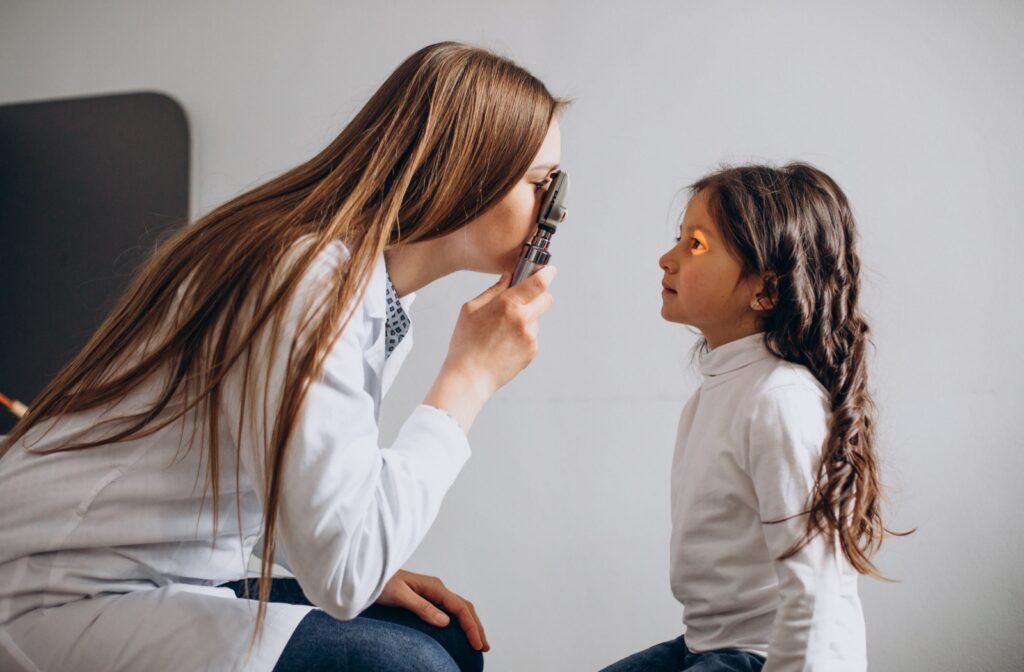Many childhood milestones are easy to track, but vision development is harder to notice without a professional eye exam.
At Visionary Eye Care, we offer specialized infant screenings through the InfantSEE® program, a public health initiative from the American Optometric Association (AOA) that provides no-cost vision assessments for babies 6 to 12 months old. These early evaluations help identify potential issues before they interfere with development.
If no concerns are found during the InfantSEE screening, we recommend beginning comprehensive eye exams at age 2 to 3 years old, unless parents notice specific concerns. After that, yearly exams are advised for children of all ages.
When Kids Need Eye Exams
Children’s eyes are constantly developing, which is why regular eye exams can help catch potential issues before they escalate. Here’s a quick breakdown of typical age milestones:
Infants (6 to 12 Months)
Our eye care clinic offers InfantSEE screenings between 6 and 12 months. This no-cost program identifies potential vision problems such as crossed eyes, misaligned eyes, focusing issues, and others that typical infant vision tests don’t detect.
Children (2-3 Years and Older)
If the InfantSEE screening shows normal development, we recommend starting comprehensive eye exams around age 2 to 3. For children, their eyesight plays an important role in supporting their newfound love of exploration and learning.
For kids who are in school, vision changes can impact their academic performance and daily interactions. For instance, undiagnosed issues like myopia (nearsightedness) can make it harder to read the whiteboard, leading to potential learning challenges. Similarly, undiagnosed hyperopia (farsightedness) can lead to difficulty focusing, headaches, and learning challenges. Early treatment can lead to stronger cognitive and social development.
What to Expect During a Child’s Eye Exam?
At Visionary Eye Care, we make exams as comfortable and engaging as possible for kids. Here’s what happens during a typical eye exam:
History & Initial Assessment
We’ll begin by discussing your child’s medical history and any concerns you might have noticed, such as excessive squinting or trouble focusing. We’ll also watch how your child tracks objects and responds to visual prompts.
Vision Tests
Age-appropriate tests are used to check for visual acuity. Younger children might identify fun shapes or pictures, while older kids use eye charts, similar to adult exams. These tests help us spot refractive errors like myopia (nearsightedness), hyperopia (farsightedness), or astigmatism.
Eye Health Evaluation
Using specialized tools, our optometrists examine the structural health of your child’s eyes. This allows us to detect early signs of conditions like amblyopia (lazy eye) or vision misalignment and recommend treatments if necessary.
Dilation Information
Parents should expect their child’s eyes to be dilated during the InfantSEE screening and again at their first comprehensive eye exam at Visionary Eye Care. Dilation allows us to get a clearer view of the internal structures of the eye and helps ensure we catch any hidden issues early.

Why Early Eye Exams Are Important
Catching and addressing eye issues early can make a huge difference in a child’s life. Here are a few reasons why:
- Supports learning: Around 80% of classroom learning is visual. Clear vision helps children stay engaged and progress academically.
- Improves confidence: Addressing vision challenges early can improve a child’s ability to participate in sports, social activities, and everyday interactions.
- Prevents long-term problems: Early detection and treatment of conditions like lazy eye can help to prevent permanent vision loss.
By identifying and addressing issues as they arise, you give your child the chance to thrive in the classroom, on the playground, and beyond. Consistent, proactive care can help prevent avoidable complications in the future.
Common Childhood Eye Conditions
Certain conditions are more common during childhood, but with timely evaluation and treatment, they’re often manageable:
- Amblyopia (lazy eye): When one eye is weaker than the other, it can lead to improper visual development. Treatment might involve corrective lenses or wearing an eye patch to strengthen the weaker eye.
- Strabismus (crossed eyes): This occurs when the eyes don’t align properly. Exercises, lenses, or sometimes more advanced treatments like surgery can correct alignment.
- Refractive errors: Myopia, hyperopia, and astigmatism are easily diagnosed and often treated with glasses or contact lenses.
With regular eye exams and early treatment, these common childhood conditions can often be corrected or well-managed, supporting healthy vision as your child grows.
Preparing Your Child for an Eye Exam
Taking the time to get your child ready for their first eye exam can make the experience enjoyable and stress-free. Here’s how:
- Explain the process: Use simple, reassuring language to describe what will happen. Say things like, “The doctor will ask you to look at some pictures and lights.”
- Make it fun: Bring along a favorite stuffed animal or snack to keep your little one feeling comfortable.
- Pick the right time: Schedule the appointment for a part of the day when your child is well-rested and not hungry.
Trust Visionary Eye Care for Your Child’s Vision Needs
Visionary Eye Care in Broomfield is proud to offer family-friendly care to kids of all ages. Proactive care from an early age can set your child up for success, helping them see their world with clarity and joy. Book your child’s eye exam today to get started.



